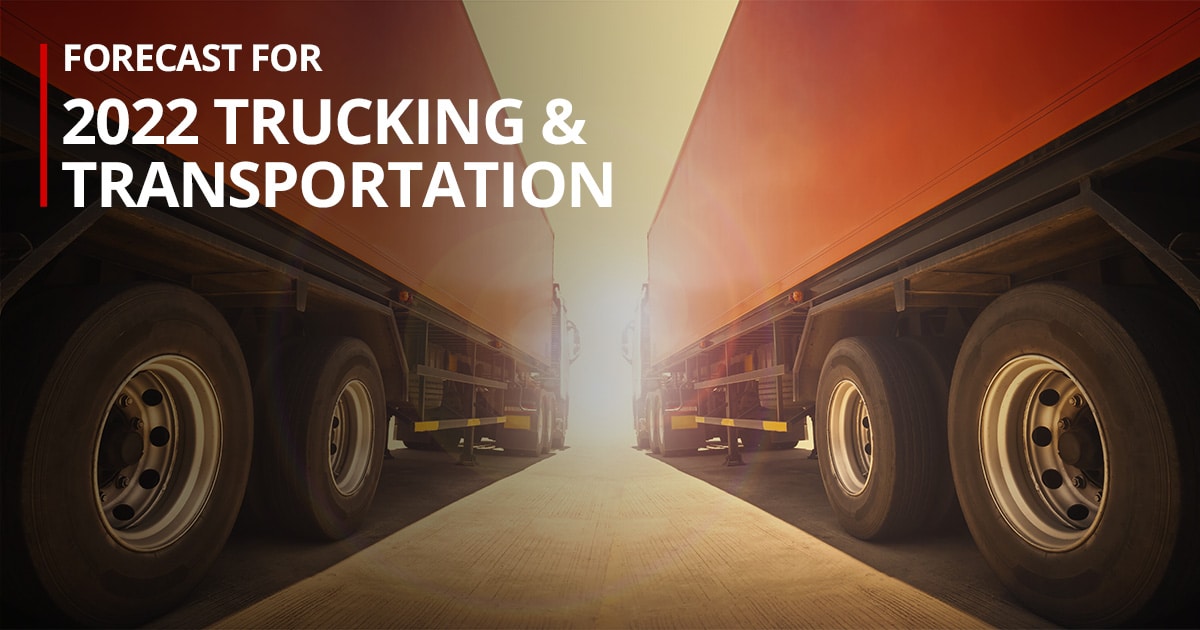2022 Trucking and Beyond
2022 Trucking and Transportation industry is still suffering from last year’s difficulties, but a brighter outlook is on the horizon.
In 2021, distribution and supply chain difficulties have been a hot topic, involving anything from microchips to food. Shoppers are annoyed by bare shelves in their local stores, delivery delays for internet orders, jammed ports, and other supply issues. People are more aware than ever before that truck drivers are responsible for the contemporary miracle of having items delivered to your home when you order them.
The constantly evolving supply chain and distribution ecosystem will see broader development in 2022 and beyond, as new levels of capability and expectations for more efficiency and transparency emerge. Changes will be driven by modern technology applications and optimized channels.
Supply chain and labor concerns will continue to affect 2022, but a brighter outlook is on the horizon. The following is the 2022 trucking, freight and distribution, transportation, delivery, and supply chain prediction.
Distribution and Freight
According to the American Trucking Associations U.S. Freight Transportation Forecast through 2022, freight tonnage will increase by 24% in 2022, resulting in a 66% increase in industry revenue. The trucking industry will account for a substantial percentage of the growth in 2022, and even over the next decade.
In a nutshell, the freight landscape in 2022 will be dominated by trucks, which will account for 70% of all freight transit, surpassing the rail industry. By 2022, freight rail’s share of the market is expected to drop to 14.6%.
While maritime transport is predicted to expand at a slower rate of 7%, the whole intermodal business is expected to rise to over $30 billion in 2022, up from $11 billion in 2016. As a result of this expansion, there is a greater demand for commercial trucking as a means of product delivery.
As the importance of trucking becomes more widely recognized, the following demands have grown:
- Road and bridge infrastructure investment
- New safety and assistance technology for commercial drivers
- Increased pressure on commercial truckers to increase their rates and pay.
Transportation and Trucking
Old difficulties will persist, but transportation operations can flourish in 2022 with a stronger economic market and brand-new problem-solving technologies. 2022 trucking will be defined by the industry’s fight to attract drivers while maintaining safety standards.
While there are plenty of business prospects in the 2022 trucking industry, there aren’t enough people to take advantage of them. The transportation industry is attempting to address the labor crisis by improving working conditions, increasing compensation, actively recruiting drivers, and increasing benefits.
Truck driver retention is a top goal, with a heavy focus on greater compensation, more benefits, better working conditions, security for female drivers, and more. Safety bonus schemes are also being implemented by fleet operators to encourage safe driving and recognize their top performers.
More driver training will be available in 2022 at community colleges and through private groups dedicated to educating qualified drivers.
Delivery
The global shipping container disruption continues to affect most businesses. Logistics costs for food and beverage firms may be a constant concern due to infrastructure and economic challenges. Shipping bottlenecks will persist in 2022, but congested ports will gradually ease thanks to the introduction of new supply chain capabilities and solutions, as well as a focus on recruiting additional truck drivers. On a more positive note, by 2026, the online meal delivery business is estimated to reach $33.7 billion.
Some delivery costs will go up. FedEx revealed their general rate increases for 2022 — this year’s GRI average rate rise is the biggest since 2013, with FedEx’s average rate increase for 2022 being 5.9%. This year’s rate hike is significantly higher than previous years. The United States Postal Service is lowering some of its charges. Parcel Select Ground, for example, would drop across the board and become extremely competitive, with discounts of up to 58 percent compared to current pricing.
Supply Chain Management
The COVID-19 pandemic posed a significant challenge to supply chains, causing them to develop over a period of months. Backlogs in materials, labor shortages, and capacity constraints continue to push businesses to innovate. The demand for goods that require computer chips is high, and supply will fall short of demand next year due to the time it takes to develop new products.
In 2022 and beyond, supply chain visibility and resiliency will be a major concern. According to Forbes, over 90% of supply chain executives believe that visibility into their supply chain is critical to their performance, yet only around a third have gained genuine visibility.
Improving Supply Chains Using Technology
Businesses are looking to digital tools to assist them manage supply chain difficulties and improve their supply chains, as well as improve operations and develop symbiotic relationships with their consumers. Technology can assist firms in successfully conducting logistics operations and addressing data quality, compliance, risk management, costs, and other issues.
According to Gartner, 50% of global eCommerce businesses will invest in real-time supply chain solutions, artificial intelligence, and advanced analytics capabilities by 2023.
Critical technologies such as Cloud, for example, will be utilized to increase supply chain visibility, improve a company’s entire customer experience, eliminate stock shortages and order backlogs, and assist disgruntled customers. Businesses will be able to visualize data from platforms and projects thanks to cloud technology, bridging the gap between operational and digital capabilities.
Supply chain digitalization will be a key priority in the coming year and beyond to minimize the dangers of information silos and allow for more accurate forecasting and planning. It entails automating processes and payments, increasing efficiency, and generating actionable data.
For supply-chain decision-makers, analytics will become a strong instrument for damage management and risk prevention. In 2022 and beyond, 80 percent of organizations will employ qualitative forecasting approaches for strategic supply chain planning. Quantitative forecasting can be used to analyze supply chain activity in the short term.
Conclusion
The freight and transportation industries in the United States and abroad have undergone significant changes in recent years. As customer demand grows, businesses have been proactive in finding solutions. Despite recovering from the Covid-19 outbreak, the 2022 trucking business has seen significant development. The forecast for 2022 is promising.
If you need fleet washing services contact LazrTek at (469) 536-8478 or email Harold@Mach1Design.com.




